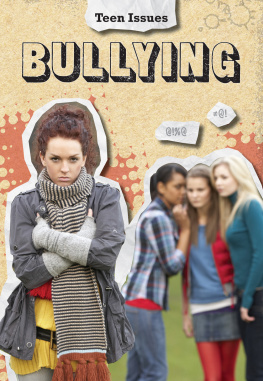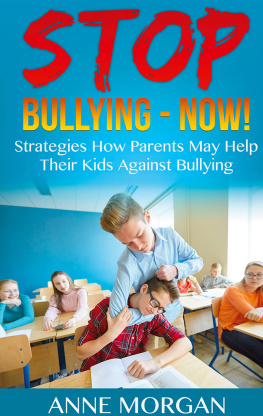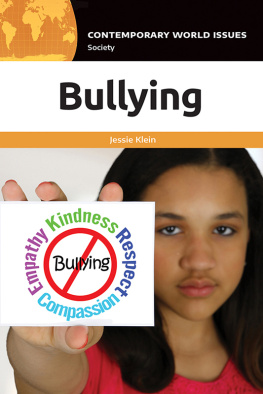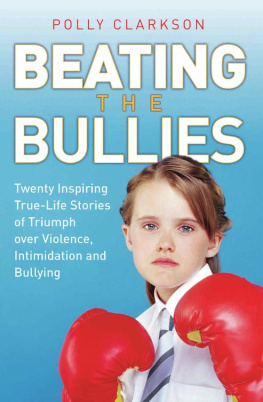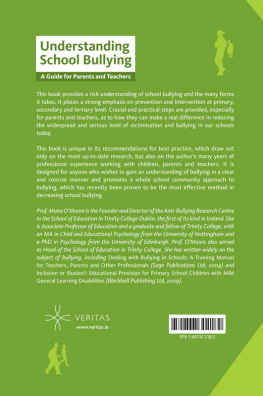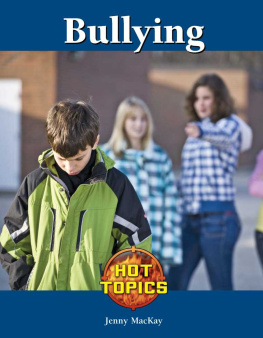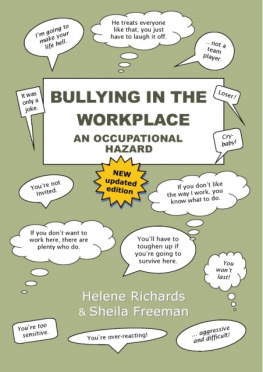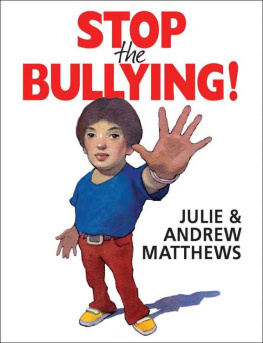Lori Hile - Bullying
Here you can read online Lori Hile - Bullying full text of the book (entire story) in english for free. Download pdf and epub, get meaning, cover and reviews about this ebook. year: 2012, publisher: Capstone, genre: Politics. Description of the work, (preface) as well as reviews are available. Best literature library LitArk.com created for fans of good reading and offers a wide selection of genres:
Romance novel
Science fiction
Adventure
Detective
Science
History
Home and family
Prose
Art
Politics
Computer
Non-fiction
Religion
Business
Children
Humor
Choose a favorite category and find really read worthwhile books. Enjoy immersion in the world of imagination, feel the emotions of the characters or learn something new for yourself, make an fascinating discovery.
Bullying: summary, description and annotation
We offer to read an annotation, description, summary or preface (depends on what the author of the book "Bullying" wrote himself). If you haven't found the necessary information about the book — write in the comments, we will try to find it.
Imagine walking around with a knot in your stomach, each day, every day. Thats how many victims of bullying feel. Others suffer more - and take their own lives. So is bullying normal? This book shows how to understand and deal with the bullying that occurs everyday in streets, schools, and the digital world, exploding some myths along the way.
Bullying — read online for free the complete book (whole text) full work
Below is the text of the book, divided by pages. System saving the place of the last page read, allows you to conveniently read the book "Bullying" online for free, without having to search again every time where you left off. Put a bookmark, and you can go to the page where you finished reading at any time.
Font size:
Interval:
Bookmark:


This candlelight vigil is being held to honor Phoebe Prince, who committed suicideafter enduring months of bullying.
- When 15-year-old Phoebe Prince moved from Ireland to a small town in Massachusettsin 2009, she quickly captured the attention of the boys at school. She went out withTodd Mulveyhil, captain of the football team, which angered Todds ex-girlfriend.She and her friends began calling Phoebe names. They knocked books out of her handsand shoved her into lockers. They bombarded her with threatening phone messages andFacebook posts, some even encouraging Phoebe to kill herself. On January 14, 2010,Phoebe walked home from school and hanged herself.
- In 2010, a group of boys wearing school uniforms led another boy across a schoolyardand struck him in the head. The boy fell to the ground, where he lay crumpled. Theboys filmed the incident and posted it on a video-sharing site.
- In 2011, Emily Nakanda, 15, cracked her knuckles before grabbing her classmate Annaby the hair and putting her in a headlock. Then she threatened to tear out Annashair. She also punched Anna and shoved her to the ground. In case anyone missed theincident, which took place in a London alley, Emilys friends filmed it on a cellphone and forwarded footage to their peers .
These true stories showcase some of the tragic consequences of bullying. While theseincidents made headlines and shocked many people, the truth is that bullying occursevery day in playgrounds, classrooms, and on computers around the globe. Fortunately,most incidences of bullying are less extreme, and many people are stepping up effortsto prevent bullying in the first place.
Of course, bullying is nothing new. The chances are your parents were bullied atsome point or knew people who were. However, a few things have changed in recentyears. For one thing, bullies can now follow their targets around not just at school,but also online and on cell phones. Insults can be broadcast instantly for the entireschoolor Internetto see. Bullies can also cause more destruction, since weaponshave become more widespread and violence has become more common.
Tragedies like the ones described on page 5 have helped alert many adults to theseverity of bullying. In the past, bullying was sometimes seen as a normal rite ofpassageas kids being kids. Bullied kids were sometimes told to toughen up. Manyof them kept quiet, partly because they felt ashamed.
Now, armed with new information about the harmful effects of bullying, many peopleare beginning to see bullying as behavior no more acceptable than child abuse. Ifparents beat their children or threaten them, the police can be called. Why shouldit be any different if it is a child making the threats or throwing the punches?Their actions harm their victims just as much, if not more. People are beginningto realize that it is bullies who should feel ashamed, not their victims.
Changing attitudes and actions is never easy. Bullying is often a cycle, since bullieshave often been bullied themselves by parents or other people. In order to stop bullying,educators, parents, communities, and young people all need to work together. Thisbook will help you to better understand bullying, so that you can do your part.
Bullying is normal.
False . Bullying may be common, just like child abuse and domestic abuse . That doesnot mean, however, that it is normal or acceptable. Bullying is antisocial behaviorthat should not be tolerated.
Bullying peaks in middle school, then tapers off in high school. However, that doesnot stop some adults from bullying, at home and in the workplace. One in six employeesexperiences bullying at work, which makes it more common than sexual harassment .Workplace bullies often spread damaging or false rumors about their coworkers orcriticize them in front of important people. These actions can increase employeestress and illness and make for a miserable work environment. Many deserving employeesalso lose the opportunity for advancement if they have been bad-mouthed by a bully.Unfortunately, there are few laws against this type of behavior, and most companieshave no rules against it. The good news is that learning how to combat bullies nowwill make it much easier to handle workplace bullies later in life.

| Normal conflict | Bullying behavior |
| Young people have a disagreement with each other. | The attack usually comes out of nowhere. The bully may try to justify his or herbehavior by blaming the victim, but the victim has done nothing to provoke the bully. |
| Both kids may experience feelings of anger or frustration. | Both kids experience very different feelings. Only one of them (the victim) feelshurt or upset. The other (the bully) sometimes gets pleasure from abusing the victim. |
| When one child shouts, the other child feels comfortable standing up for himselfor herself. | Only the bully is allowed to shout. If the victim expresses hurt or anger, the bullymay mock the victim or express indifference. |
| Young people may take turns starting an argument, and disagreements happen only occasionally. | The bully always starts the fight and abuses the victim repeatedly. |
| Young people may find it possible to resolve the issue through discussion. | The conflict is impossible to resolve, because there is no real conflict. |
Everyone has disagreements. Some conflicts can even be healthy, because they canhelp you learn how to resolve problems. However, it is important not to mistake bullyingfor normal, acceptable conflict.
So, what exactly is bullying? Is it punching or shoving someone? Taunting or name-calling?What about excluding another person from a group? Making racist remarks? Bullyingcan take any of these forms. It is most commonly defined as any ongoing physical,social, or verbal abuse that is intended to harm the victim (often called a target),who is less powerful in some way.
There are three main elements that make bullying bullying:
- An imbalance of power between the bully and the target : The child who bullies maybe stronger than his or her victim, or better at flinging insults or threats. Thebully may also be more confident than the target and have more friends, or more popularfriends, to back him or her up. This is called social power.
- Intent to harm : A bully does not accidentally step on your toe and then say sorry.A bully stomps on your foot in a deliberate attempt to hurt or upset you. The bullymay apologize, but the apology is insincere.
- Ongoing aggression : Bullying is rarely a single occurrence. Usually the bully repeatshis or her behavior, often in the same places, as a way to establish dominance. Manyof these spots lack adult supervision, which allows kids to bully without gettingcaught. Bullies often threaten to make the targets life miserable if he or she evertells an adult.
Font size:
Interval:
Bookmark:
Similar books «Bullying»
Look at similar books to Bullying. We have selected literature similar in name and meaning in the hope of providing readers with more options to find new, interesting, not yet read works.
Discussion, reviews of the book Bullying and just readers' own opinions. Leave your comments, write what you think about the work, its meaning or the main characters. Specify what exactly you liked and what you didn't like, and why you think so.

